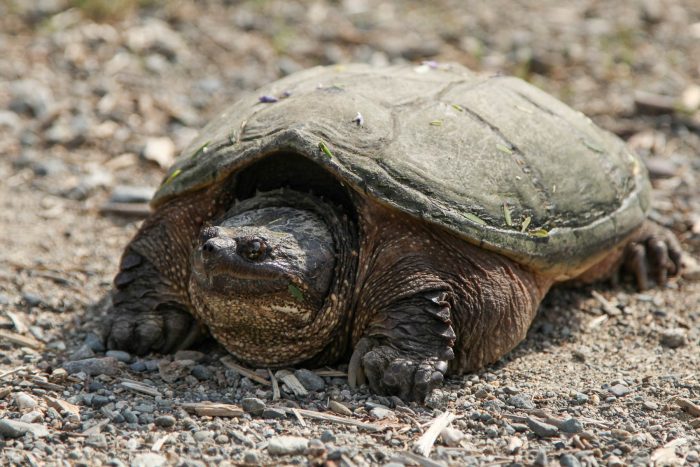Common Snapping Turtle
Chelydra serpentina
The common snapping turtle is the largest freshwater turtle in the Chesapeake Bay watershed. It lives in both freshwater and brackish water environments.
This section shows one large critter image at a time. Use the thumbnails that follow to select a specific image to display here.

This gallery contains a grid of small thumbnails. Selecting a thumbnail will change the main image in the preceding section.
Appearance
Snapping turtles have large claws, an alligator-like tail, a thick shell and scaled legs. The top of their jaw extends over the lower half and their nostrils sit at the very top of their nose.
Feeding
Their diet includes plants and animals. They will eat aquatic vegetation and hunt insects, reptiles, amphibians, small mammals and birds.
Predators
Snapping turtles are most vulnerable when they are in eggs and newly hatched. At this stage they are preyed upon by foxes, coyotes, skunks, minks, fishers, raccoons, crows, herons, hawks, owls, bullfrogs, fish and snakes. Adult snapping turtles have very few predators but are sometimes attacked by river otters, bears and coyotes. In the southern United States, where their territory overlaps, snapping turtles are preyed upon by American alligators and alligator snapping turtles.
Reproduction and life cycle
Mating always occurs in the water each spring between May and June. After mating, females will travel up to one mile to find a suitable nesting site. Females will dig a hole and lay 10-50 eggs and cover the eggs to hide them from predators. The eggs will hatch in August and the hatchlings travel to the nearest waterway. They will reach sexual maturity at 10-15 years old. During the coldest months of the year, snapping turtles will bury themselves in the mud and slow their metabolism. They can stretch their long necks up to the surface of the water to breathe or absorb oxygen from the water and mud.
Did you know?
- The snapping turtle is the state reptile of New York.
- Some scientists believe that snapping turtles use the earth's magnetic field to navigate to nesting sites.
- Snapping turtles are hunted for food in the United States and exported to other countries for the international aquaculture business and as canned meat. In 2016, the common snapping turtle was one of four turtles listed in the Endangered Species of Wild Fauna and Flora (CITES). The listing meant that all international trade of snapping turtles would be monitored to protect the population.
- Hunters and anglers should always check with their local wildlife department to see if there are consumption advisories in place for fish and turtles. As a predatory aquatic species, snapping turtles can accumulate toxins that make them unsafe to eat.
- The related alligator snapping turtle, which can grow much larger, has only been spotted in the watershed as a released species and not a native species that can survive our cold winters. In 2020, a 65-pound alligator snapping turtle was captured in Alexandria, Virginia and transferred to the Virginia Zoo in Norfolk, Virginia.
